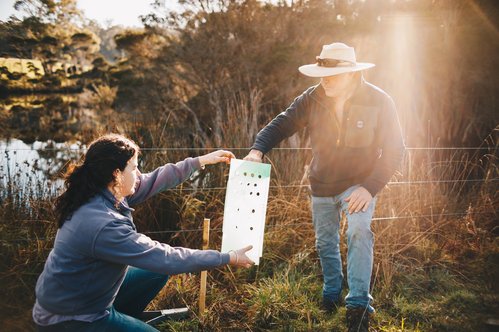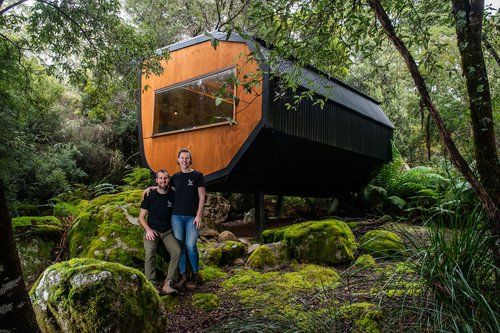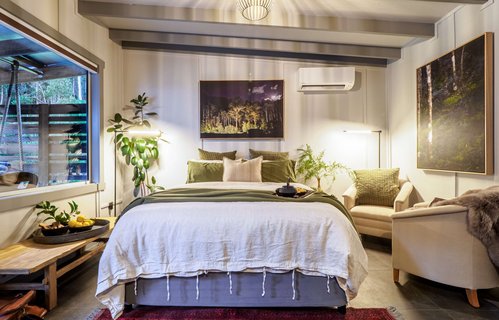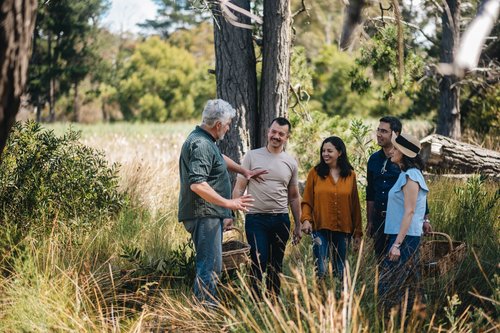Case studies
There is already a thriving community of tourism and hospitality businesses dedicated to a more carbon conscious Tasmania.
Read on to understand how, and why, some of Tasmania's tourism businesses are working to reduce their business-related emissions...
Martha Vale Park (Program: Tourism Emissions Reduction)

Anna Williams and father Ross have meticulously transformed their century-old stables into luxurious sustainable accommodation on the East Coast of Tasmania.
At the heart of Martha Vale Park's philosophy lies a deep commitment to regenerative agriculture practices, which guide its every endeavor. The team's primary aim is to nurture vibrant, life-sustaining soils.
Offering regenerative farming tours, plus onsite accommodation at its luxuriously restored century-old stable, father and daughter duo Ross and Anna Williams are deeply committed to showing guests how conscious choices can shape the future of our food systems and natural environment.
Q&A | Anna Williams, Martha Vale Park
Anna, how did you find the TERC program?
The TERC program was straightforward and easy to navigate. What stood out most was its ability to provide us with a clear understanding of the emissions from the tourism side of our business—something we hadn’t calculated before. It also offered practical strategies for reducing emissions, which inspired us to get creative in how we approach sustainability.
What have you changed within your business as a result of the program?
We’ve implemented several changes as a result of participating in the program:
Sourcing: I now evaluate products for packaging, location, and whether there’s a locally made substitute. For example, we replaced some ‘eco’ products delivered in plastic with supplies from a Tasmanian-owned company for our cleaning products and a local maker for bath bags and room sprays.
Waste: I thought about ways as to how I could bring customers along with us and one opportunity was waste. We introduced a compost bin for our worm farm. Guests love interacting with the worm farm—many have never seen one before.
Energy Monitoring: The program encouraged us to think critically about energy consumption. While we haven’t been open for a full year yet, we plan to benchmark emissions each season. Our solar panels already power the Stables, but achieving full self-sufficiency isn’t feasible right now. The benchmarking will help us track progress and refine strategies. Without this program, I likely wouldn’t have prioritised an understanding of our emissions or explored mitigation strategies as thoroughly.
What are the key benefits of the TERC program for tourism operators, in your view?
The TERC program is simple to follow and provides actionable strategies for reducing emissions. It also sparks a bit of creative thinking. One surprising benefit for us was discovering areas where we were already mitigating emissions—this allowed us to communicate those efforts to our guests.
Blue Derby Pods Ride (Program: Tourism Emissions Reduction)

Credit: Blue Derby Pods Ride Experience
For Blue Derby Pods Ride, a luxury adventure mountain bike riding experience based out of Derby in Tasmania's Northeast, sustainability isn't the end goal - it's the ethos that guides each and every business decision.
Owners Tara and Stephen Howell powered their way through the TERC program in a matter of hours - you can read the Action Plan here.
Q&A | Tara Howell, Blue Derby Pods Ride
Tara, you are already doing so much as a business to minimise your impact on the environment – what motivated you to sign up to our TERC program?
Operating Blue Derby Pods Ride in a sustainable way has always just been status quo for us, so the TERC program was an opportunity to formalise what we do but also get inspiration for other ideas on how we improve.
Once logged in, how did you find the process?
I was relieved to find it incredibly intuitive! I definitely have had a perception that programs can be 'clunky'. This definitely was not the case here, every step felt valid and helpful. I really enjoyed the process and it gave us an opportunity to reflect on every we do with the team which was an added bonus.
Did the process help you to uncover and commit to new actions to decarbonise within your business?
It definitely highlighted areas we are still working on and therefore regained our focus. For example, we have been working for a long time now to create a sustainable jersey option for our team and guests, we're so close now and desperately want to change the action to 'complete' on our plan!
Where do you hope to see the tourism industry, with respect to environmental sustainability, in the next 5 years?
In an ideal world, in 5 years' time the tourism industry would see sustainability as a normal part of business. For example, we complete our tax returns, just as we get our carbon audited. Further to that, it would be wonderful to see all business adopt sustainable suppliers. The small actions make a collective big difference, we've got to remember this mentality.

Laid Back Manor is a new luxury accommodation business based in the beautiful Huon Valley.
Laid Back Manor (Program: Net Zero Activation)
Laid Back Manor is one of the Huon’s newest accredited tourism businesses, and markets itself as a relaxing, luxury weekend stay. But when it comes to emissions reduction action – the husband-and-wife duo that operate the accommodation business are anything but laid back.
In just under a fortnight, owners Adam and Kylie Quilliam have progressed to Stage 4 of the TICT’s Net Zero Activation program. This means that all that the business needs to do now is follow through on its emission reduction actions and keep track of these goals into the next year.
“When the opportunity to participate in the Net Zero program came along it was just what we were looking for. At Laid Back Manor, we showcase the natural Tasmanian wilderness, both flora and fauna. Being aware of our emissions and impact on our land is a constant focus of our business,” explained Kylie.
“We appreciated that this initiative was a step in the direction Laid Back Manor was already going, therefore it was a natural inclusion into our existing business practices.”
Kylie said that using the ERC tool has helped them as a business to better understand how to track their emissions, as well as communicate that information to guests. They are excited to be able to share their business’s short and long-term emissions reduction plans for brand awareness and marketing purposes.
“Completing the ERC Action Plan was not a resource intensive process - it included actions we have already taken, options we were considering, and suggested actions which we weren’t aware of. It allowed us to set realistic, manageable and flexible goals for emissions reduction,” said Kylie.
“We now have an emissions reduction plan we can be guided by, update, and adapt when required.”
Check it out - Laid Back Manor's action plan. It took Kylie all of 15 minutes.
Laid Back Manor is one of the 70+ Tasmanian tourism businesses that took advantage of the TICT Emissions Reduction Initiative in the first round.
Sirocco South (Program: Tourism Emissions Reduction)

Photo by Harrison Candlin - Vagary
Offering gourmet foraging tours to visitors in Tasmania’s south, accredited tourism operator Sirocco South has a modest carbon footprint of around 5.9 tonnes CO2/year. But owner Mic Giuliani’s climate ambitions go much further; and as an active participant in the TICT’s TERC program, he is taking action to reduce his business’s emissions even further.
We sat down for a Q&A with owner Mic Giuliani, to learn more about why he thinks this work is important.
Why were you motivated to take climate action & reduce the emissions associated with your tours, Mic?
I think we all have a responsibility to look at what we do and how it impacts our world. It’s imperative that we take action wherever we can to reduce our footprint. The nature of my tours attracts guests that want to know more and are actively aware of what’s happening to the world. If I can show that we are making a positive contribution every time we conduct a tour, then we are more likely to satisfy that need in them.
How did you find the TERC program process? Was it easier or harder than you’d initially thought?
The process is pretty straight forward - web site is well set out and easy to follow, the support offered by the team is excellent too so if you are having any problems don’t hesitate to ask!
Did it take you long?
I managed to get it done in a couple of hours.
Would you recommend the TERC Program to other Tasmanian tourism businesses?
Most definitely. We are all responsible for leaving this place in a better condition than we found it - the TERC program is an excellent way to see where you are right now, and it gives you some ideas around how to get some quick wins on the board!
What kind of actions have you committed to via the TERC program?
Since committing to net zero I have installed a large solar array and I am currently working towards setting up the mobile kitchen as “off grid” with a battery bank (to be recharged via the grid when at home) to replace the silent petrol-driven generator currently used.